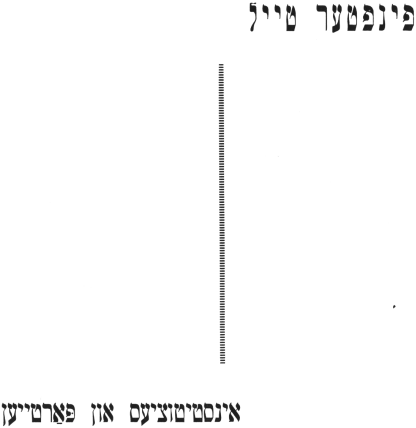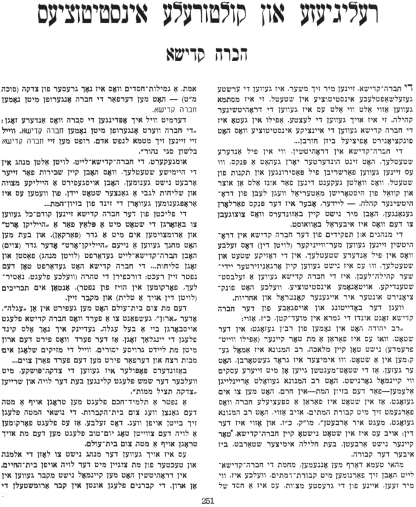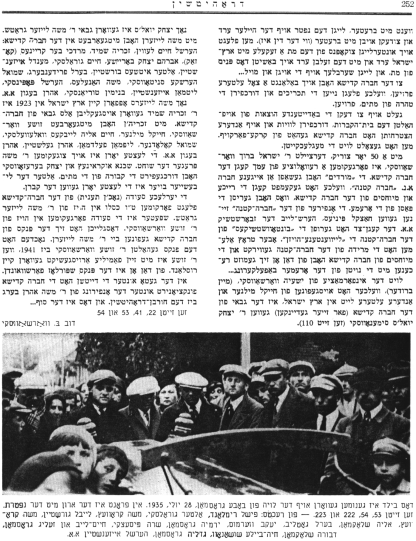Previous Page
|
Next Page
[p. 249 blank]

[Page 250]
PART V
INSTITUTIONS AND PARTIES

[Page 251]
RELIGIOUS AND CULTURAL INSTITUTIONS
The Burial Society - Chevra Kaddisha
The Chevra Kaddisha was apparently the first community institution in town. It was apparently as old as the Drohitchin Jewish community itself. It was also the last community institution. Even in the ghetto, the Chevra Kaddisha was the only entity to function officially until the Holocaust.
Like in many other communities, the Drohitchin Chevra Kaddisha/Burial Society had maintained a record book for hundreds of years. This book contained the events, rules and regulations of the community, and could have served as a treasure house and fountain of historical material about the life of the Drohitchin community. Unfortunately, the book was lost, and we have no other source of information that was known elsewhere.
The customs and roles of the Burial Society in Drohitchin were more or less (according to law) the same as in many other towns. In those communities that didn't have an organized Jewish community, the Chevra Kaddisha was the independent and autonomous institution that functions under its own responsibility and control.
The Talmud in Tractate Moed Katan, p. 27, describes the task of the Jewish burial society:
“Rav Yehuda said in the name of Rav: In a town where a deceased is found, no one (even total strangers) many not perform any type of labor. Rav Hamnuna once came to a town where someone had just died. He noticed that the people in town were going about their business as usual, and because of this disgrace of the deceased, Rav Hamnuna wanted to excommunicate all the people in town. He was told that there was a special organization in town that cared for the dead. If so, said Rav Hamnuna, you may continue working.” This is the provision of Jewish law: if there is no burial society, no one may work from the moment of death until the burial is completed.
For this reason, because the burial society members are involved with caring for the dead, a person may continue his activities. Caring for the dead is one of the greatest mitzvahs there is. It is a real true good deed and charity, and is greater than the mitzvah of monetary charity (see tractate Sukkah, p. 49). This is why the society is called in Aramaic the Holy Association [Chevra Kaddisha].
Therefore, I want to agree with the following statement: “The Association should be called Holy Association because they render themselves ritually impure by contact with the dead they are called by the opposite connotation, i.e. Holy.”
According to the old practice in the towns in the Old Country, the burial society members never received monetary compensation for their work, and undertook their sacred task on behalf of an entire community of Jews, who no longer are considered to have committed the sin of ignoring a deceased.
The task of the Burial Society was first of all to make sure the community had a cemetery surrounded by a fence. During the dedication of the cemetery or fence, the Burial Society members had provide the deceased with what he deserved, namely water purification (which was performed, of course, in the house of the deceased), cover him with the burial sheets (including a tallith/prayer shawl according to Jewish law) and bury him.
The deceased was transported to the cemetery in a wagon or a casket harnessed to a horse that the Society borrowed from a wagon driver. I still remember how the children used to say that the horse that took the casket and the deceased suffered great pain because the demonic forces would be beating the horse mercilessly. This is why the horse was in front of the bridle.
The charity tin box was especially popular, and the synagogue custodian would bang the tin, announcing that charity keeps death away.
A deceased Talmudic scholar would be transported on a board the entire distance to the cemetery. The pallbearers would switch off during the procession. This would also take place for a funeral of anyone that took place on the second day of Yomtof. There was also a custom not to let the widow or her daughters accompany the deceased to the funeral.
No one was ever buried in a casket in Drohitchin. The gravediggers would place
[Page 252]
 wooden boards in the grave by placing the deceased at the bottom of the grave and cover him up with the boards (as Jewish law provides for). There was also the custom of putting a small bag of earth from the Holy Land under the head of the deceased and to sprinkle it over his face. In addition, pieces of pottery would be placed over the eyes and mouth.
wooden boards in the grave by placing the deceased at the bottom of the grave and cover him up with the boards (as Jewish law provides for). There was also the custom of putting a small bag of earth from the Holy Land under the head of the deceased and to sprinkle it over his face. In addition, pieces of pottery would be placed over the eyes and mouth.
A few elderly women were also members of the burial society, and they would handle the preparations and purification for deceased women. The burial society covered the expenses of maintaining the cemetery, holding funerals and other activities by selling plots. People would pay according to their financial ability.
R. Yisrael Baruch Warshavsky recounted that fifty years ago there was a “rebellion” of the common people against the burial society. The “rebels” started their own small society that went to battle against the wealthy and those of illustrious pedigree who ran the burial society and who tore up the belts of the poor. The leaders of the small society were Chatzkel Pines, Hersh-Leib the “Fence Builder” and others. The opposition referred to the “insurrectionists” of the small society as the “linen pants.” Nevertheless, the rebellion worked, and the aristocrats of the burial society had to begin considering the needs of the poor population.
According to Yeshayahu Warshavsky (my brother), who heard from Chaikel Milner and other elderly people in Palestine, the custodian of the burial society was, as far as they could remember, R. Yitzchak Yoel's Simenovsky (see p. 110).
After Yitzchak Yoel's, R. Moshe Leizer Gratch served as custodian, and the following individuals worked together with him in the burial society: Hershel Chaim Levine, Zechariah Schmid, Mordechai Ber Kreines (Kozack), Avraham Yitzchak Boreisha, Chaim Goralsky, Mendel Eisenstein, Alter Itches Burstein, Berl Friedenberg, Shmuel Hershka Snitovsky, Moshe Haneles, Hershel Popinsky, Litman Eisenstein, Binyamin Toriansky, Aharon Begun and others.
After Moshe Leizers moved to Palestine in 1923, R. Zechariah Schmid was chosen as the custodian of the Burial Society. Schmid's colleagues were: Zusha Warshavsky, Chaikel Milner, Chaim Eliyahu Leibkes Valevelsky, Shmuel Kolodner, Lipman Feldman, Aharon Gelstein, Aharon Begun and others. In the final year R. Moshe Prager the ritual slaughterer also participated. Shachna Ukrainetz and Yitzchak Berezovsky handled burials of the deceased. Alter, the builder from Liebesha, was the gravedigger in the final years.
The annual dinner (following the fast) of the Burial Society took place on the 15th of Kislev at the home of R. Moshe Gratch, and later in the home of R. Zusha Warshavsky. R. Moshe Leizers was also responsible for the record book of the Burial Society. Thereafter, R. Zusha maintained it until 1941, when he and his family were exiled to Russia. The record book then was lost. The Burial Society functioned in the ghetto under the direction of R. Moshe Aharon Berg until the final Holocaust of Drohitchin. That was the end of it.
| See pp. 22, 41, 53 and 54. |
Dov B. Warshavsky |
[photo caption:]
This photograph was taken at the funeral of Bobba Grossman on July 28, 1935. In the front is the casket with the deceased. See pp. 53, 54, 222 and 223. From right: Fishel Rimland, Alter Goralsky, Moshe Kravetz, Leibel Gurstein, Moshe Kravetz, Eliyahu Shlackman, Berl Gottlieb, Yaakov Wermus, Yirmiyahu Grossman, Sarah Pisetsky, Chaim-Leib and Zelig Grossman, Devorah Shlackman, Chaya-Beila Shushanov, Gedaliah Grossman, Hershel Eisenstein and others.
Previous Page
|
Next Page
This material is made available by JewishGen, Inc.
and the Yizkor Book Project for the purpose of
fulfilling our
mission of disseminating information about the Holocaust and
destroyed Jewish communities.
This material may not be copied,
sold or bartered without JewishGen, Inc.'s permission. Rights may be
reserved by the copyright holder.
JewishGen, Inc. makes no representations regarding the accuracy of
the translation. The reader may wish to refer to the original material
for verification.
JewishGen is not responsible for inaccuracies or omissions in the original work and cannot rewrite or edit the text to correct inaccuracies and/or omissions.
Our mission is to produce a translation of the original work and we cannot verify the accuracy of statements or alter facts cited.
 Drogichin, Belarus
Drogichin, Belarus
 Yizkor Book Project
Yizkor Book Project
 JewishGen Home Page
JewishGen Home Page
Yizkor Book Director, Lance Ackerfeld
This web page created by Lance Ackerfeld
Copyright © 1999-2025 by JewishGen, Inc.
Updated 13 Dec 2001 by LA


 wooden boards in the grave by placing the deceased at the bottom of the grave and cover him up with the boards (as Jewish law provides for). There was also the custom of putting a small bag of earth from the Holy Land under the head of the deceased and to sprinkle it over his face. In addition, pieces of pottery would be placed over the eyes and mouth.
wooden boards in the grave by placing the deceased at the bottom of the grave and cover him up with the boards (as Jewish law provides for). There was also the custom of putting a small bag of earth from the Holy Land under the head of the deceased and to sprinkle it over his face. In addition, pieces of pottery would be placed over the eyes and mouth. Drogichin, Belarus
Drogichin, Belarus
 Yizkor Book Project
Yizkor Book Project
 JewishGen Home Page
JewishGen Home Page